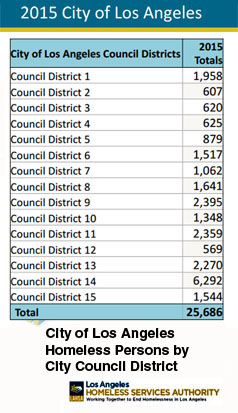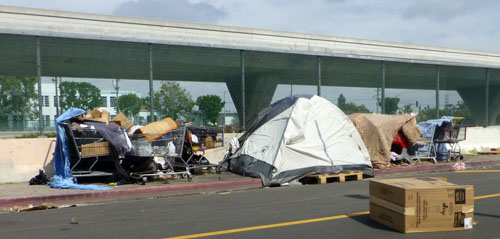Los Angeles Homeless Numbers Continue to Grow as Weak Recovery Enters Its Seventh Year
Leslie Evans
There are 25,000 homeless people in the city of Los Angeles; 44,000 in the county. Those are the raw numbers found by the Los Angeles Homeless Services Authority from its late January three-day point-in-time nighttime count, in which 5,500 volunteers, this writer included, went out and covered every block of 89% of the census tracts in Los Angeles County. The bad news is that this is 12% more than were found two years ago.
The findings were presented by LAHSA’s Executive Director Peter Lynn at a well-attended May 11 meeting of its Commission at its Wilshire Blvd. headquarters in downtown Los Angeles. I was one of those in the audience.
As Lynn expanded his report, the subpopulations showed worse damage. Those found to be unsheltered in the city in this year’s count, that is, living in the streets, were 17,687, up 18.6% from two years ago. The rest on the nights of the count were in various public and charity homeless shelters. And of those on the streets, there was an incredible 85% increase in people living in tents, under plastic tarps, in RVs, and automobiles.
Los Angeles has the greatest number of homeless in the nation. There are many reasons for this. Our city has the fifth most expensive rents in the country, after San Francisco, New York, Boston, and Washington, DC, with median rents for a one-bedroom apartment at $1,740, and two-bedrooms going for $2,406. Current California minimum wage is
$9 an hour, or $1440 a month before taxes. The national standard of affordability is supposed to be no more than one third of a family’s income on rent or mortgage. A large number of L.A.’s poor spend up to two-thirds of their income on rent, while 18% of the people of Los Angeles County live in poverty, higher than the state or national average.
There is little affordable housing, mental health care, or housing specifically for the homeless, except for veterans.
The homeless are not distributed evenly among the city’s 15 council districts. Of course, José Huizar’s CD 14, which includes both Skid Row in Downtown and Boyle Heights in East LA, has the lion’s share, with an estimated 6,292. Much of the Valley, with CDs 2, 3, 4, 5, and 12, have fewer than 1,000 each.
Three districts were counted at just over 2,000: 9, 11, and 13. For 9, the homeless are in the area in South L.A. around USC, then the district stretches east of the Harbor Freeway into a commercial and warehousing area. CD 11 picks up some poor areas in Palms and Venice. CD 13 has a number of neighborhoods that include low-income sections such as Koreatown, Rampart, Echo Park, and East Hollywood.
The rest of the council districts all have homeless in the 1,000 range.
Who Are the Homeless?
The popular perception seems to be that the homeless are mainly the mentally ill and drug and alcohol abusers. Extensive demographic street surveys that followed the count found that picture to be only partially true. Survey questionnaires were administered to several thousand homeless persons. The survey categories are not mutually ex
clusive, as one person might have more than one condition. The surveys were for the whole 44,359 countywide homeless contingent.
27.6% were found to be mentally ill. 23.4% were drug or alcohol abusers. But 19.8% were victims of domestic violence, and 18.4% were disabled.
After Peter Lynn concluded his presentation a black woman in the audience angrily insisted that virtually all the homeless are African Americans and that most of the shelter aid and housing is going to illegal immigrants. Commissioner Kelvin Sauls, who is pastor of the Holman United Methodist Church and was born in South Africa, responded that he is black and an immigrant, and that we must all remain united if we are to end homelessness.
Peter Lynn then produced statistics on the ethnic breakdown from the homeless survey that are not yet on the LAHSA website.
39% were African American
27% Latino
25% white
5% described themselves as multiracial
4% declined to state.
The main statistics from Peter Lynn’s presentation are available on the LAHSA website (www.lahsa.org ). Further details will be added there in the future.
Comments
Leave a Reply
You must be logged in to post a comment.




